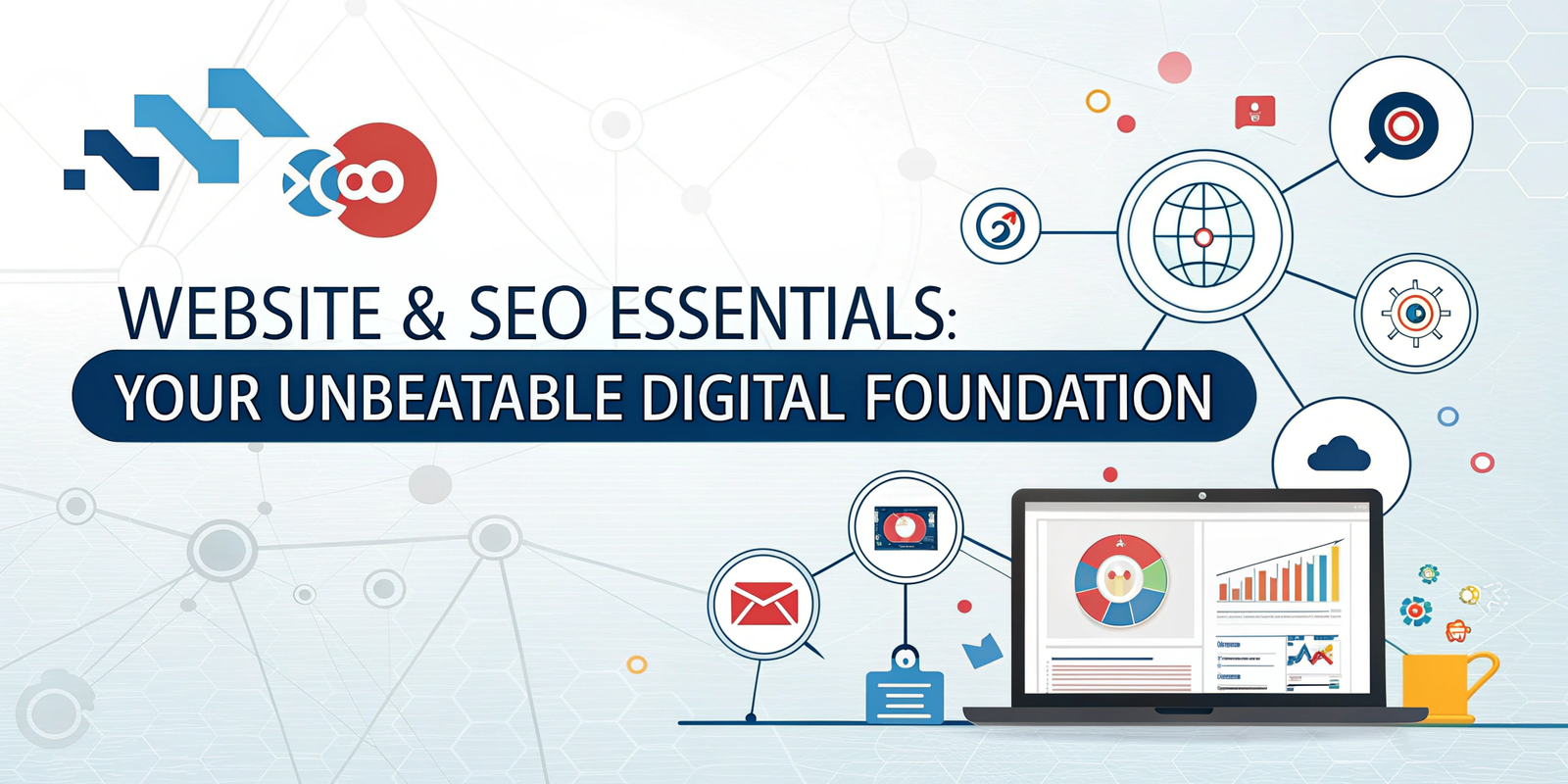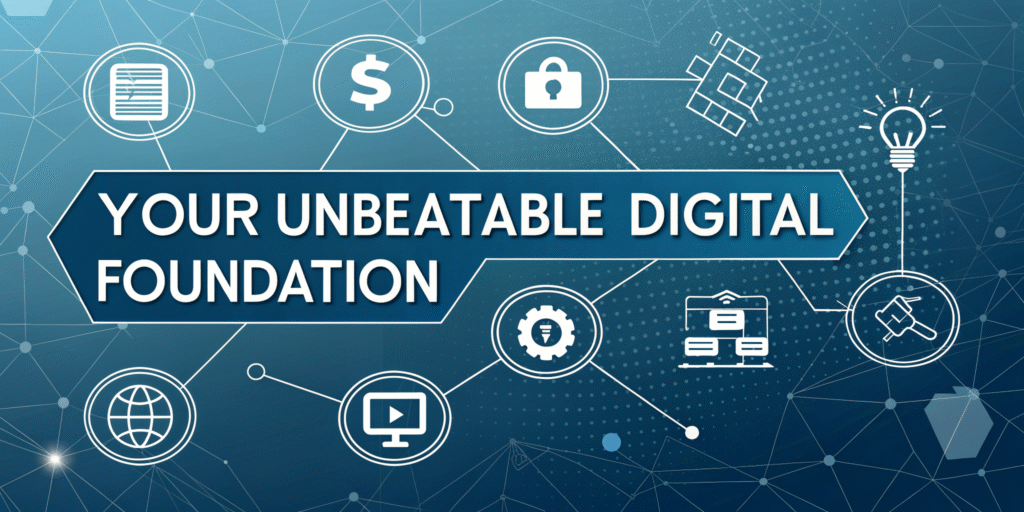
Table of Contents
- Your Website: More Than an Address, It’s Your Digital Home
- Phase 1: Laying the Technical Cornerstone
- Phase 2: On-Page SEO – Speaking the Language of Search Engines & Users
- Phase 3: User Experience (UX) – The Silent Salesperson
- Conclusion: Your Foundation is Built—What’s Next?
1. Your Website: More Than an Address, It’s Your Digital Home
In the first post of this series, we established that the digital marketplace is the new main street. If that’s true, then your website is your permanent storefront, headquarters, and sales team, all open 24/7. Unlike a social media profile you don’t fully control, your website is your owned digital asset. It’s the central hub where all your marketing efforts—social media, email campaigns, paid ads—should ultimately lead.
But a website alone isn’t enough. A beautifully designed store is useless if it’s hidden down a dark alley with a locked door. Search Engine Optimization (SEO) is the process of putting up clear signs, paving the road to your door, and making sure it’s wide open and welcoming. It ensures that when people are searching for what you offer, they can find you.
This guide breaks down building this foundation into three critical phases: the Technical Cornerstone, On-Page SEO, and User Experience (UX).
2. Phase 1: Laying the Technical Cornerstone
Before writing a single word of content, you must ensure your website is built on stable, fast, and secure ground. This is technical SEO.
Domain Name & Hosting: Choosing Your Plot of Land
- Domain Name: Choose a name that is your business name or clearly describes what you do. Keep it short, memorable, and easy to spell. A
.comextension is still the most trusted. - Web Hosting: Your hosting provider is the land your store is built on. Don’t choose the cheapest option; it often leads to slow speeds and frequent downtime, which both users and Google hate. Invest in reliable, quality hosting. It’s the bedrock of everything.
SSL Certificate: The Non-Negotiable Security Lock
An SSL certificate encrypts data between the user’s browser and your server. You can tell a site has one if the URL begins with https:// (instead of http://) and has a padlock icon.
- SEO Impact: Google explicitly states that HTTPS is a ranking signal. Sites without it are marked “Not Secure,” which drastically increases bounce rates.
- User Trust: Would you enter your credit card information on a site labeled “Not Secure”? Neither will your customers. This is non-negotiable for any modern website.
Site Speed: Why Every Millisecond Counts
Speed is a critical ranking factor for Google and a paramount user experience factor.
- User Impact: A 1-second delay in page load time can lead to a 7% reduction in conversions. People are impatient; if your site is slow, they will hit the back button and visit a competitor.
- How to Check & Improve: Use free tools like Google PageSpeed Insights or GTmetrix. They will analyze your site and give specific recommendations, such as:
- Optimizing image sizes (e.g., saving images as WebP format).
- Leveraging browser caching.
- Minimizing code (CSS, JavaScript).
Mobile-First: Designing for the Majority
Google now uses mobile-first indexing, meaning it primarily uses the mobile version of your site for indexing and ranking. Over 60% of web traffic comes from mobile devices.
- Action: Use a responsive website design that automatically adjusts to fit any screen size—desktop, tablet, or phone. Test your site on multiple devices. If it’s hard to read or navigate on a phone, you are failing the majority of your audience.
3. Phase 2: On-Page SEO – Speaking the Language of Search Engines & Users
This is where you create content that answers users’ questions and signals to search engines what each page is about.
Keyword Research: Finding What Your Audience is Searching For
You must use the words your potential customers are using. This isn’t about guessing; it’s about research.
- Tools: Use Google Keyword Planner, Ahrefs, SEMrush, or even look at the “People also ask” and “Related searches” sections on Google.
- Strategy: Target a mix of:
- Head Terms: Short, broad keywords (e.g., “running shoes”) – high competition.
- Long-Tail Keywords: Longer, more specific phrases (e.g., “best stability running shoes for flat feet”) – lower search volume but much higher intent and easier to rank for. These are often goldmines for conversion.
Title Tags & Meta Descriptions: Your 2-Second Pitch
These are the first things users see in search results. They are your prime real estate for earning a click.
- Title Tag (
<title>): This is the most important on-page SEO element. Keep it under 60 characters. Include your primary keyword, ideally near the front, and your brand name.- Example:
Stability Running Shoes for Flat Feet | YourBrandName
- Example:
- Meta Description: This is your ad copy. It should be a compelling summary of the page (under 155 characters) that includes your keyword and a call-to-action.
- Example:
Struggling with flat feet? Discover our top-rated stability running shoes for ultimate comfort and support. Shop now with a 30-day guarantee.
- Example:
Header Tags (H1, H2, H3): Structuring Your Content for Clarity
Headers (<h1>, <h2>, <h3>, etc.) create a logical hierarchy for your content, making it easy for both users and search engines to read.
- H1: The main title of the page. There should only be one per page.
- H2: Main section headers.
- H3: Sub-points under an H2.
Use keywords naturally in your headers to reinforce the page’s topic.
Content Quality: The Undisputed King
You can do everything else right, but without high-quality content, you won’t succeed. Google’s algorithms are increasingly sophisticated at measuring E-E-A-T (Experience, Expertise, Authoritativeness, and Trustworthiness).
- Create for People First: Write comprehensive, original content that fully answers the user’s search query better than any other result on the first page.
- Depth Matters: A 1,500-word in-depth guide will typically outperform a 300-word thin page.
Internal Linking: Building a Web of Relevance
Link from one page on your site to another relevant page. This does three things:
- It helps users discover more content and stay on your site longer.
- It helps search engines understand the structure and hierarchy of your website.
- It spreads “link equity” (ranking power) from your strong pages to newer or less prominent ones.
4. Phase 3: User Experience (UX) – The Silent Salesperson
SEO traffic is useless if visitors leave immediately. A good experience makes them stay and convert.
Clear Navigation: Don’t Make Me Think
Your website’s menu should be simple and intuitive. A confused user is a user who hits the back button. Make it incredibly easy to find key information like About Us, Contact, and main product/service categories.
Clear Call-to-Action (CTA): Telling Users What to Do Next
Every page should have a purpose and a clear next step for the user. What do you want them to do?
- “Buy Now”
- “Sign Up for Our Newsletter”
- “Contact Us for a Free Quote”
- “Read Our Related Guide”
Make these buttons stand out with contrasting colors and action-oriented text.

5. Conclusion: Your Foundation is Built—What’s Next?
A technically sound, well-optimized, and user-friendly website is not a “nice-to-have”; it is the absolute foundation of any successful digital marketing strategy. It’s the asset you fully control that works for you around the clock.
You’ve built your stunning, well-signed, and secure storefront on a busy digital street. But how do you attract a crowd to come inside? In our next post, we’ll move from architecture to attraction. We’ll dive into Content Marketing: Crafting a Strategy That Attracts and Converts, where you’ll learn how to create the valuable, magnetic content that makes people want to visit your store in the first place.
Action Item: Run your website through Google PageSpeed Insights and check your mobile responsiveness today. Identify one technical improvement you can make this week.